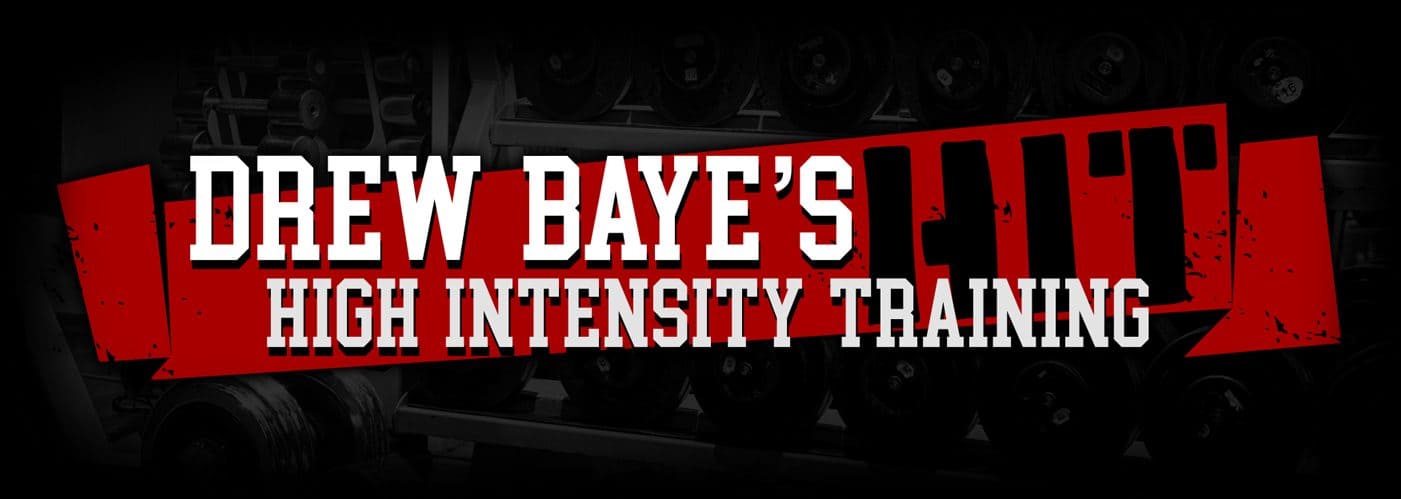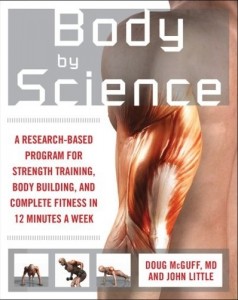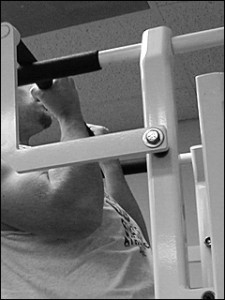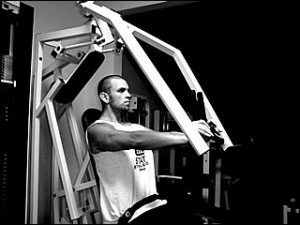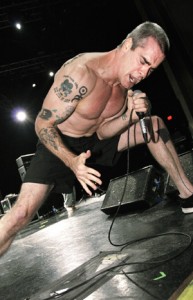I recently received a prototype from a new line of machines from Randy Rindfleisch, the inventor of the Eccentric Edge leverage machines and Xntrx motorized machines. It is an isokinetic, multi-exercise machine providing both positive and negative resistance, and can be used for several exercises and a variety of protocols.
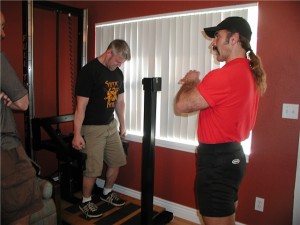 There is no weight stack or plates to lift or lower. The resistance is entirely motorized. Movement is controlled through touch sensitive pads on the ends of the handles. The user contracts against the handles or shoulder pads as they move positively and negatively, attempting to speed up the positive and slow down the negative. The users effort is then displayed on a readout in front of them, which can be used to evaluate progress between workouts.
There is no weight stack or plates to lift or lower. The resistance is entirely motorized. Movement is controlled through touch sensitive pads on the ends of the handles. The user contracts against the handles or shoulder pads as they move positively and negatively, attempting to speed up the positive and slow down the negative. The users effort is then displayed on a readout in front of them, which can be used to evaluate progress between workouts.
This provides several advantages over conventional equipment.
When using free weights or conventional machines, you normally select a weight that will allow you to perform some number of repetitions or some duration of work, which is a compromise between having a heavy enough weight that the tension on the muscles is high enough but not so much that you can’t maintain that tension for adequate duration to induce a significant amount of microtrauma and metabolic byproducts of fatigue to stimulate growth. When you do this the only time your muscles are contracting as hard as possible is the point when their momentary strength has been reduced to the level of the selected resistance. From the start of the exercise up until that point, they are not working as hard as possible.
Since the muscles are capable of resisting far more force during the negative than they can contract against during the positive, they are worked even less intensely during the negative when using conventional equipment. For example, if you can lift 100 pounds at in an exercise you can lower about 140 pounds under control at about a 4/4 cadence (the ratio of positive to negative strength varies with concentric contraction speed). If you select 80 pounds of resistance for an exercise, you are lifting 20% less weight and lowering over 40% less weight than you are capable of at the start of an exercise. Since the negative portion of an exercise is the most important for stimulating growth, this is a serious shortcoming.
There is a way around these problems using conventional equipment called “hyper” repetitions, a protocol used in the early days of Nautilus which required several helpers to assist the trainee in lifting a weight far heavier than they would use for a normal set, then applying additional resistance during the negative, resulting in maximal difficulty in both the positive and negative portion of the exercise. However, hyper reps are somewhat impractical to perform, very tiring for the helpers, and can be dangerous if done improperly, and make it difficult to objectively quantify performance.
The machine makes it possible to perform hyper repetitions with no assistance and in complete safety since there is no weight to be dropped. The movement arms will instantly come to a smooth stop (stop and turnaround acceleration is adjustable) and remain still at any position if the user takes their thumb off the sensor. On the prototype effort is measured as draw on the motor and displayed in front of the user, and the production model will have a screen in front of the user displaying the force applied at the movement arm, making it possible to objectively quantify performance and evaluate progress between workouts.
It also makes it more practical to perform other advanced high intensity training techniques like negative-only and Max Contraction. From a personal trainer’s standpoint, this saves a tremendous amount of physical effort. If you’re training a dozen or more people per day several days per week and using forced reps, negatives, forced negatives, static holds, etc., it can get pretty tiring. Additionally, this makes it possible for a small female trainer to have clients perform hyper or negative only reps with a level of resistance she could never lift for them with conventional machines or free weights. It also makes it possible to perform exercises like squats and deadlifts negative only, which are otherwise highly impractical.
Since the resistance equals the effort throughout the exercise, it automatically accommodates the user’s strength curve over the full range of every exercise. Since strength curves vary between individuals, especially in linear movements where the start and end points vary with limb length, and may even vary somewhat from repetition to repetition due to different rates of fatigue in muscles of different fiber type composition whose relative contribution to a movement varies somewhat from position to position, this is something that is impossible to accomplish with free weights or conventional weight-based machines. Even other motorized machines which alter the resistance between repetitions or between the positive and negative through manipulation of weight selection or levers can’t do this.
Sunday night I performed a brief workout on the machine, consisting of squats, pulldowns, presses and calf raises. The speed of the machine is currently set to 10/10, although it can be adjusted to be faster or slower. I performed three “hyper” repetitions of each, with a maximal effort during both the positive and negative, and took about about two minutes of rest in between. The total workout time was around 12 minutes. I have performed negative only and hyper reps before, but it doesn’t even begin to compare to this. The negatives were particularly brutal. The machine is surprisingly smooth – I think the turnarounds would even impress Ken Hutchins – and the controls are incredibly responsive. Switching positions between exercises is easy and quick – the seat for dips, pulldowns, presses and shrugs can be removed for the leg exercises, although when set to the lowest position it is out of the way for deadlifts and calf raises. The seat height is adjustable, and I have trained a friend who is 6’2″ and 200 pounds and my wife who is 5’2″ and 95 pounds with no problems.
Thursday night I performed a negative-only workout, consisting of squat, row, chest press and stiff-legged deadlift, doing three 10 second negatives of each with approximately 10 seconds between reps. Although the negatives were still brutal, the workout wasn’t quite as exhausting without the positives even though I only rested about a minute between exercises. The total workout time was under 10 minutes. Normally I would perform additional work for the forearms and additional direct arm work occasionally, however I want to evaluate the results from using the machine only, so I will not be using any other equipment for the next couple weeks.
The machine was designed specifically for squats, calf raises, deadlifts, dips, pulldowns, presses and shrugs, but also works well as a chest press or compound row if you lay on the seat and use the seat belt to hold yourself down for the row, and I suspect bent over rowing and stiff legged deadlifts may also work well, although you wouldn’t be in a position to view the screen. Randy has designed another machine for chest press and seated row, though, so I don’t know if this one will be modified to be better suited to the performance of those exercises. That other machine was designed for leg press, calf raise, chest press, seated row, and leg curl, and also provides an abdominal exercise.
Based on what I’ve been able to do with it so far, I’m planning on rotating between the following workouts on it, and will film some of these to post here:
Routine A:
- Squat
- Pulldown
- Shoulder Press
- Stiff-Legged Deadlift
Routine B:
- Deadlift
- Dip OR Chest Press
- Row
- Calf Raise
I am also going to be training a few friends and family members over the next couple months, and will report on their progress with the machine as well.
Update September 2018: I would caution people against using hyper reps on these/continuous max effort. I will eventually write an article with updated protocol recommendations for motorized machines.
